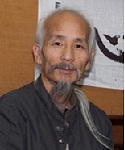| Biography | |
|---|---|
 Prof. Yang Lee Gyeongsang National University, Republic of Korea |
|
| Title: Gih to Meditation; Zen with Tea: 茶禪一如 | |
| Abstract: It has been argued that Gih can be refined as integrating mind and matter (Lee, Shaw, &Jin 2017). Gih works in meditation since the latter is conceptualized as regarding both mind and matter. The reciprocity inherent in meditation is illustrated by some of its popular aphorisms as茶禪一如 (Tea and Zen are same; Choi, 1980). This study asked how tea would match to Zen. Since tea is matter, they must be conceptualized to work in mind, as Tea-Gih. With the same point, Zen is an ideal entity as, say, “mindfulness,” which must be transformed to work in matter as Zen-Gih. Thus this study propounds that Zen-Gih is construed as an example of “Embodied” mind (Borrett, Kelly, &Kwan, 2000;Dove, 2016), while Tea-Gihis as instances of “Enminded” matter. This line of conceptualization used the affordance-based control exhibited by archers (Lee, Lee, Carello, &Turvey, 2012) as an experimental paradigm to analyze Tea-Gih and Zen-Gih. This framework refines psychosomatic in terms of dual directions, extending to philosophical discussions as phenomenology (Haship, 2015).To demonstrate an empirical approach, this study showed some psychosomatic phenomena induced by respiration control, heart-rate and neural activity in processes of body, and coincident with mindfulness and emotion in terms of mind events,owing to conditions of that atea-rite was practiced. The results were discussed in respect to what would be theoretically related (e.g., Turvey, 2012). Thus. this study concluded that Gihcould modulate tea rite to realize Zen.
Key words: Gih,Meditation, Zen with Tea(茶禪一如), Embodied, Enminded, Psychosomatic
Borrett, D., Kelly, S.,&Kwan, H., (2000). Bridging embodied cognition and brain function: the role of phenomenology. Philosophical Psychology. 13(2), 261-266. Choi, B. (1980). Tea-Zhen, Jinju: Dasolsa Dove, G. (2016). Three symbol ungrounding problems: Abstract concepts and the future of embodied cognition. Psychonomic Bulletin and Review, 23(4), 1109-1121. Haship, H. (2015). Phenomenon of life and death by Dōgen and Heidegger––in view of “embodied cognition” in Buddhist philosophy and phenomenology.Asian Studies, 3, 105-128. Lee, Y., Lee, S., Carello, C., &Turvey, M. T. (2012). An archer's perceived form scales the "hitableness" of archery targets. Journal of Experimental Psychology: Human Perception and Performance, 38, 1125-1131. Lee, Y., Shaw, R. E, &Jin, Z (2017). Gih (Qi): Beyond affordance. Frontiers in Psychology. 8, 556. doi: 10.3389/fpsyg.2017.00556. Park, Y (1990). Sword-Zhen, Jinju: Namhaedojang. Turvey, M. T. (2012). From physical education to physical Intelligence: 50 years of perception-action by Michael T. Turvey. The Journal of the PhilosophicalInterdisciplinary Vanguard (AVANT), 3, 128-138. | |
| Biography: His scholarly post is a distinguished professor at Gyeongsang National University, Republic of Korea, and a senior scientist at Haskins Laboratory, Yale University, US. His Ph. D was earned from Seoul National University, Republic of Korea, by a thesis concerned to ‘phonology and morphology’, the problems of which have been analyzed further by his recent papers (Lee & Callero, 2016) and granted successively by N. I. H. His research propensity is represented by his paradigm as ‘Gih’ (Lee, Shaw, & Jin, 2017), which is posited as one of ‘the third entities’ to integrate ‘mind and body’, and ‘subject and object’. The Gih paradigm is refined on ‘scientific philosophy’ and applied to review the problems of ‘language’, ‘social relation’, and ‘perception and action’, which let him known as a cognitive psychologist and a scientific philosopher. Adding personally, what he is absorbed in is practice of some martial arts. | |
